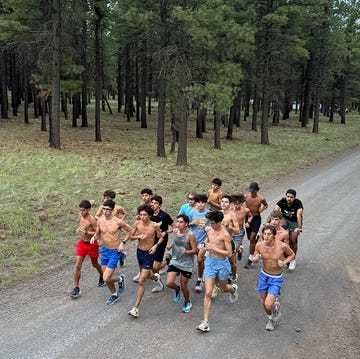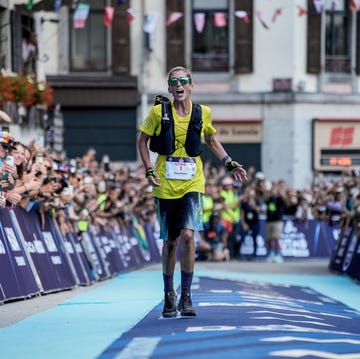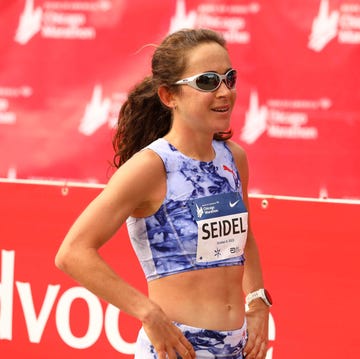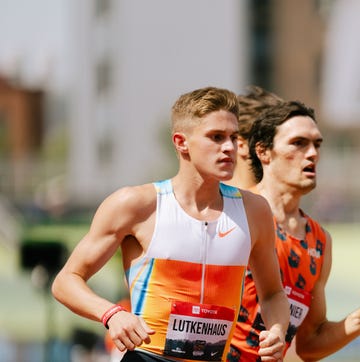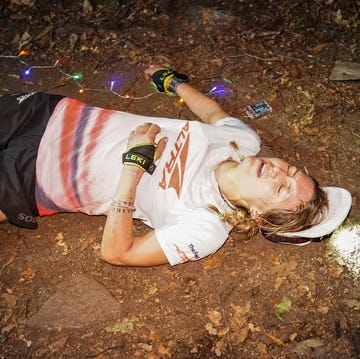As someone who grew up in South Carolina but has lived in Pennsylvania for three years, I’m still learning how to dress in the winter. More importantly, I’m trying to figure out what gear works best—and is cheap.
Often, I find that college kids strike this balance the best. They’re frugal and inventive.
A few weeks ago, I ran into Maura Timoney on a run. She’s a senior at Lafayette College and is a member of their track and cross-country teams. It was a chilly day; I was standing shivering on a street corner waiting for my buddy to meet for our run, as she jogged past with her trademark “sittens.” Sock mittens.
Timoney has Raynaud’s syndrome, a condition which causes poor blood circulation to the extremities, like fingers and toes. In high school, her hands would get so numb on cold days that she couldn’t untie her shoes. So her coach suggested that she wear socks as gloves. The rationale? Since socks don’t have fabric that separates fingers like gloves, the body heat stays trapped better.
Timoney soon realized that the strategy worked, and she’s been doing it since then for any run below 45 degrees or so. She reserves the same pair of Under Armour crew socks for her hands—nothing fancy.
After bumping into her, I tried the method out myself on a few runs. I put on a pair of semi-threadbare Adidas quarter socks for my 7-mile jaunt in mid-30s weather. And it worked. Mostly.
My hands were warm throughout the run, and my wrists, especially, were cozy. On a colder run later in the week, I tried out some merino wool hiking socks that were even more insulated. Plus, I’m a firm believer that the best running gloves also act as a good handkerchief for wiping your nose. Socks are perfect for this.
However, there are two immediate drawbacks to wearing socks as gloves.
One is dexterity; I found it more difficult to press the buttons on my watch without full use of my fingers, and if I wanted to use my phone or eat a gel, it was near-impossible without taking them off.
The second is the wind. The day I wore the merino wool socks was gusty, and while my palms were plenty warm, the outside of my hands took some wind. (Perhaps a more optimistic way of looking at this is that they’re breathable.)
Still, I was encouraged by my experiment. And I was surprised at how common wearing socks as gloves is.
Between my trial runs, I put out a poll on my Instagram story, asking my runner friends if they’ve ever worn socks as gloves. Surprisingly, most had. Of the 53 people who answered, 34 of them (64 percent) said they’d tried it out before.
Joe Allegro, a junior at Moravian University, wears them exclusively. In high school, his coach—Jim Schlentz at Colts Neck High School in New Jersey—would pass out socks to his athletes who didn’t have gloves. The distance team, which is routinely one of the top in the state, would wear them on brisk days during cross-country season or before races.
“I thought it was normal everywhere,” Allegro says.
Many of the Colts Neck alumni who now compete in college still keep up the practice. Like Timoney, Allegro feels like the socks keep body heat trapped better than conventional gloves. He saves his nicer socks for his feet and wears his worst ones on his hands. “Most of the time I’m not even matching,” he says.
For some runners, sock gloves are reserved for special occasions.
Alex Predhome, a 31-year-old tech worker (and popular running meme poster) who lives in Somerville, Massachusetts, has made socks a part of some of his biggest races. While he typically sticks to traditional gloves on training runs, on cold race days, he’ll often opt for tube socks.
He first tried them in a race at the 2018 Philadelphia Half Marathon. It was a cold November morning, but Predhome expected to warm up throughout the race. So instead of worrying about stashing his gloves in his shorts or discarding them entirely, he threw on a pair of cotton tube socks. He didn’t care if he had to part with them, similar to how runners at major marathons will wear throwaway clothes while waiting in the corrals.
“I just liked the idea of having disposable clothes that I wasn’t emotionally attached to at the time,” he says.
The socks were so comfortable that Predhome forgot to take them off. He wore them again the following month at the USATF Club Cross-Country Championships in Spokane, Washington. The race was only a 10K, but Predhome chose long soccer socks this time, in effect, acting as arm warmers in addition to gloves.
Predhome solved the dexterity issue, too. At the Philly Half in 2019, he cut five small holes for his fingers in one hand, so he could grab water cups and fuel. When he wasn’t reaching for anything, he would retract his fingers back inside the sock. (He admits he sort of reinvented the concept of gloves here.)
Predhome, along with Timoney and Allegro, have leaned in to their sartorial choices. The two college runners pride themselves on being sock wearers, and they don’t worry about the occasional weird glance from a passersby. “I guess it’s become my thing on the team,” Timoney says.
Predhome last wore sock gloves during a race at the 2023 Boston Marathon. It was a cool day, made cooler by the spitting rain. This time, though, Predhome ditched the socks when they started to get soggy before the 10 mile mark. He finished the race in 2:29:48—his second-fastest marathon to date.
This April, he’ll wear them again on Marathon Monday if it’s cold.
“Not all gear needs to be flashy,” he says. “If it works, it works.”
Theo Kahler is the news editor at Runner’s World. He’s a former all-conference collegiate runner at Winthrop University, and he received his master’s degree in liberal arts studies from Wake Forest University, where he was a member of one of the top distance-running teams in the NCAA. Kahler has reported on the ground at major events such as the Paris Olympics, U.S. Olympic Trials, New York City Marathon, and Boston Marathon. He’s run 14:20 in the 5K, 1:05:36 in the half marathon, and enjoys spotting tracks from the sky on airplanes. (Look for colorful ovals around football fields.)






